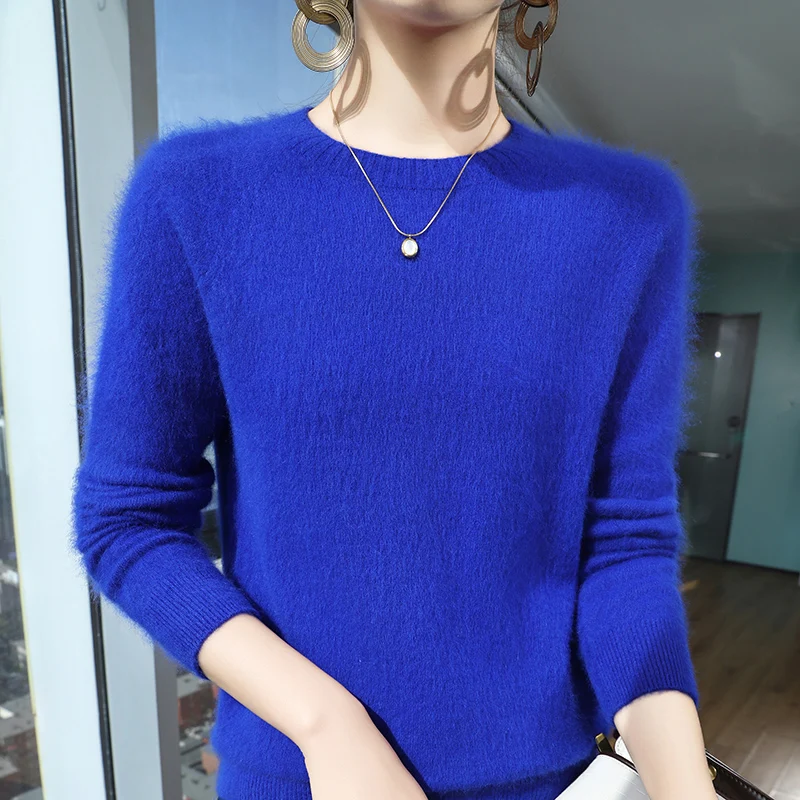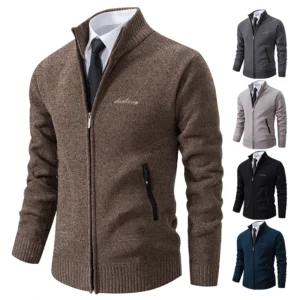Understanding the World of Luxury Cashmere
Cashmere stands as one of the world’s most coveted luxury fibers, prized for its remarkable combination of softness, warmth, and lightweight comfort. This extraordinary material comes from the undercoat of cashmere goats, which develop an incredibly fine, insulating layer to withstand harsh mountain climates. What makes cashmere truly special is its unique combination of properties that regular wool simply cannot match – exceptional softness against the skin, superior warmth without bulk, and a natural breathability that adapts to your body.
Within the realm of fine cashmere, two distinct expressions have emerged over time: the “classic” and the “brushed” finish. These two approaches to cashmere treatment create notably different experiences for the wearer, each with its own set of characteristics and ideal uses. Understanding the differences between these two cashmere feels is essential when investing in quality garments that should bring joy for years to come.
At Estate Cloth, we focus exclusively on superior premium luxury cashmere fibers that meet exacting standards. The distinction between brushed and classic finishes represents more than just manufacturing techniques – it reflects different philosophies about how luxury should feel and function in everyday life.
Throughout history, cashmere has been treasured by royalty and connoisseurs of fine textiles. Today’s processing techniques have evolved to enhance different aspects of cashmere’s natural properties, allowing for either the preservation of its traditional character or the transformation into something with a different tactile quality. Let’s explore how these different approaches create two distinct cashmere experiences.
The Essence of Classic Cashmere Feel
Classic cashmere represents the traditional approach to this premium fiber, highlighting its natural characteristics through minimal intervention. The production process for classic cashmere follows time-honored techniques that preserve the fiber’s inherent qualities. After harvesting the fine undercoat from cashmere goats, the fibers undergo careful sorting, cleaning, and combing to remove impurities while maintaining structural integrity.
The refined fibers are then spun into yarns using methods that preserve their natural alignment and characteristics. These yarns are woven or knitted into fabrics that maintain cashmere’s inherent properties without additional finishing treatments that would significantly alter the fiber structure. This traditional approach allows the natural qualities of cashmere to shine through in the final product.
When you touch classic cashmere, you’ll immediately notice its distinctive hand feel. The texture is remarkably smooth and dense with a refined silkiness that glides against the skin. There’s a natural elasticity to classic cashmere that allows it to gently hug the body while maintaining its shape. The surface feels polished and uniform, with a subtle slickness that distinguishes high-quality cashmere from ordinary wool.
Visually, classic cashmere exhibits a tight, clean appearance where individual stitches or weave patterns remain clearly defined. The surface has a subtle natural sheen that catches light beautifully, creating a gentle luster that’s neither flat nor overly shiny. This characteristic gleam comes from the natural properties of the fiber rather than artificial treatments.
The performance of classic cashmere is equally impressive. It provides exceptional warmth despite its lightweight nature—a hallmark of fine cashmere that makes it practical for various seasons. The fabric breathes naturally, adapting to body temperature changes while maintaining excellent insulation properties. The natural drape of classic cashmere creates elegant, fluid lines that complement the body’s movement.
By preserving cashmere’s natural structure through traditional processing, classic cashmere maintains the full spectrum of properties that have made this fiber so coveted throughout history. The integrity of the fibers remains intact, allowing the natural drape benefits styling options that wouldn’t be possible with more heavily processed materials.
The Distinctive Traits of Classic Cashmere
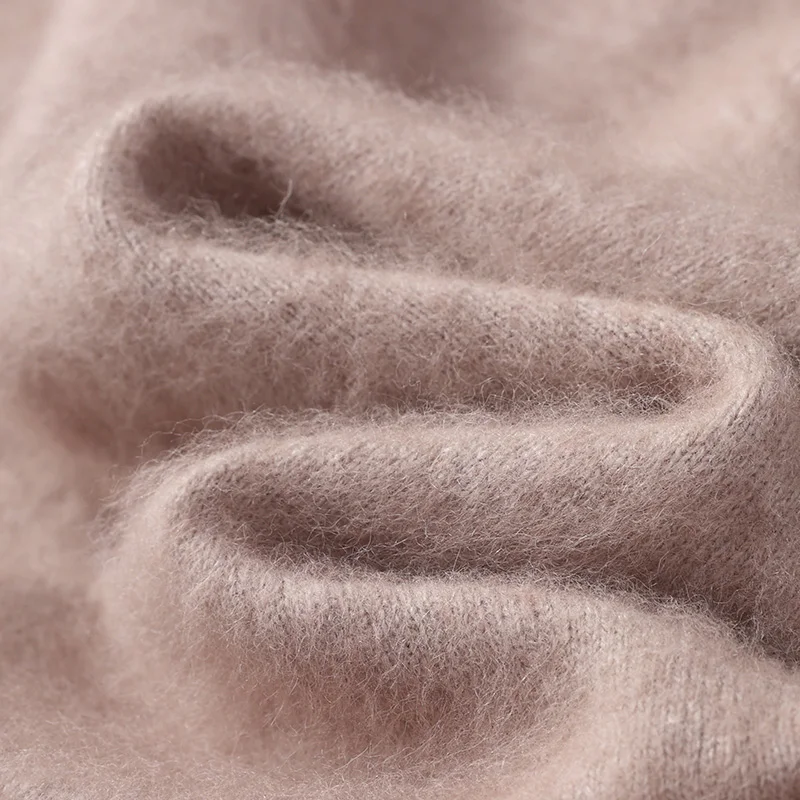
Classic cashmere possesses several distinctive characteristics that define its luxury status and wearing experience:
Elegant drape and movement: Classic cashmere flows gracefully with the body, creating clean lines and sophisticated silhouettes. The natural weight and structure of the unaltered fibers allow garments to hang beautifully.
Superior resilience and shape retention: Without the disruption of fiber alignment that comes with brushing, classic cashmere maintains excellent recovery. Garments hold their shape remarkably well through repeated wearing.
Refined visual clarity: The surface texture allows for crisp stitch definition in knitwear and clean lines in woven pieces. This clarity showcases the craftsmanship behind each garment.
Subtle luminosity: Classic cashmere possesses a gentle, natural luster that creates dimension and visual interest as light plays across its surface.
Smooth, uniform texture: The consistent surface feels incredibly smooth against the skin, with a polished quality that feels luxuriously refined.
When wearing classic cashmere, these qualities translate into a sophisticated experience that combines comfort with elegance. The material moves with you rather than against you, creating a second-skin feeling that’s both protective and barely noticeable. The smooth surface slides easily under outerwear without bunching or creating bulk.
Perhaps most notably, classic cashmere develops character over time in a way few other materials can match. With proper care, the durability and aging properties of classic cashmere actually improve through gentle use. The fibers relax slightly while maintaining their essential structure, creating a garment that becomes increasingly personalized to its owner without sacrificing its refined appearance.
The technical reason behind these qualities lies in the preservation of cashmere’s natural fiber alignment. Without the disruption of brushing, the fibers maintain their parallel orientation, allowing them to slide against each other smoothly while maintaining cohesion as a fabric. This structural integrity is what gives classic cashmere’s smooth texture and drape its distinctive character.
Popular Applications for Classic Cashmere
The refined properties of classic cashmere make it perfectly suited for certain types of garments and accessories where structure, drape, and sophisticated appearance are priorities:
Fine gauge sweaters and cardigans: The smooth surface and excellent drape of classic cashmere creates elegant lightweight sweaters with clean lines and crisp stitch definition. These pieces work beautifully for both casual and formal settings.
Elegant scarves and wraps: Classic cashmere flows gracefully when used in accessories, creating fluid movement and sophisticated draping that frames the face and adds polish to any outfit.
Tailored outerwear and coats: The natural structure and resilience of classic cashmere allow it to maintain shape in structured pieces while providing exceptional warmth without bulk.
Sophisticated accessories: From gloves to hats, classic cashmere creates refined accessories that combine practicality with elegance.
Premium blankets and throws: In home goods, classic cashmere creates throws and blankets with beautiful drape that lay elegantly across furniture while providing exceptional warmth.
Classic cashmere excels in these applications because its natural properties complement the design intentions perfectly. The material’s inherent structure supports clean lines and defined shapes while maintaining comfort. For instance, classic cashmere cardigans can be styled in countless ways precisely because they maintain their shape and drape beautifully over other garments.
The visual clarity of classic cashmere also makes it ideal for showcasing intricate knitting patterns, fine gauge work, and subtle details. This is why many fine gauge classic cashmere garments feature elegant ribbing, delicate cables, or sophisticated textures – the material allows these design elements to remain crisp and visible.
Season-wise, classic cashmere works remarkably well across three seasons in most climates. Its natural temperature regulation keeps it comfortable from early fall through spring, with lightweight versions even appropriate for cool summer evenings. This versatility makes classic cashmere pieces particularly valuable as wardrobe investments.
The Luxurious Nature of Brushed Cashmere Feel
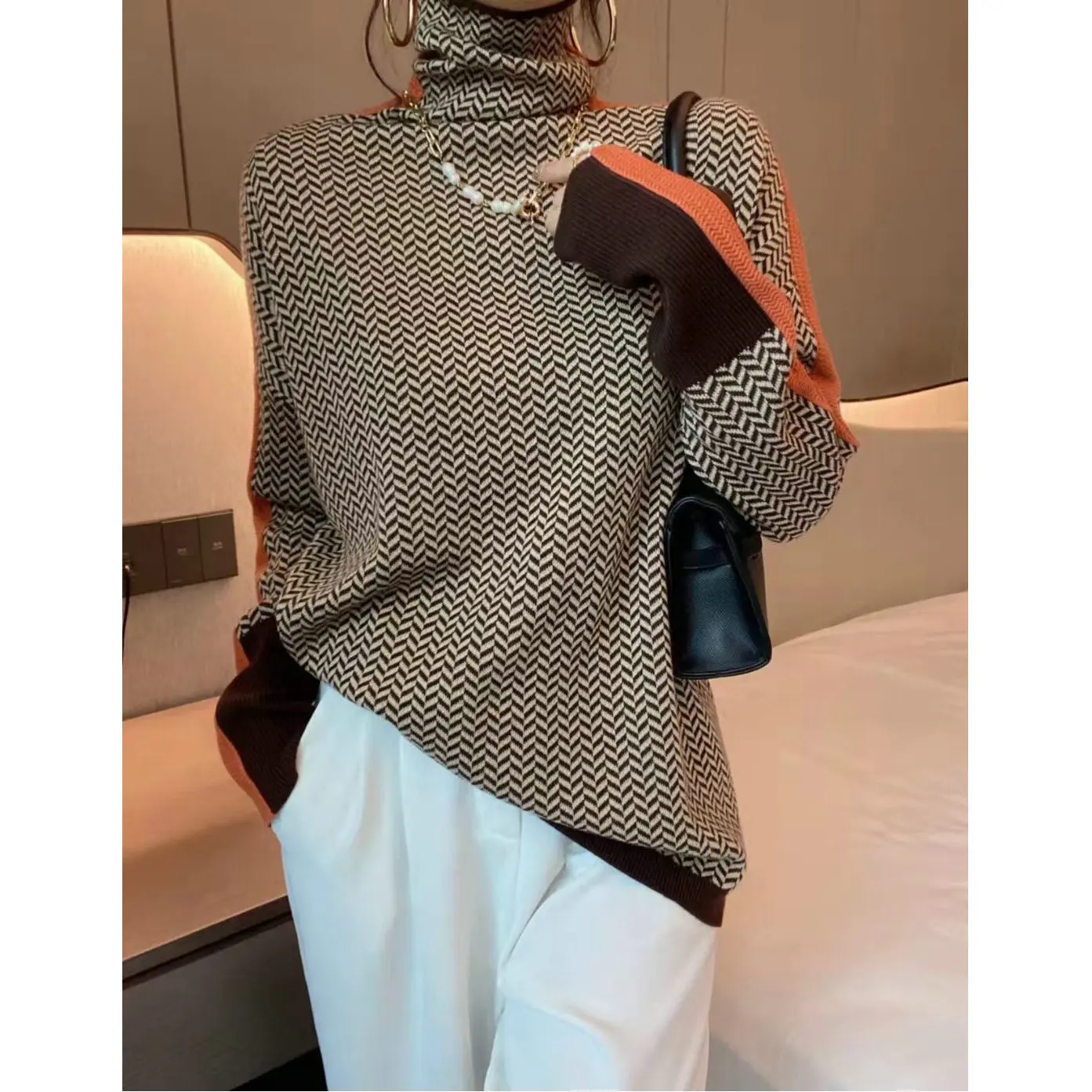
Brushed cashmere represents a different approach to luxury, one that transforms the traditional characteristics of cashmere into something with an entirely different sensory experience. The distinguishing feature of brushed cashmere is the additional finishing process it undergoes after the material has been woven or knitted.
This brushing process involves carefully running the finished fabric against fine metal bristles or specialized brushing equipment. This action gently lifts and separates the surface fibers, creating a halo effect of tiny raised fibers across the fabric’s surface. The process must be precisely controlled – too little brushing won’t achieve the desired effect, while excessive brushing could potentially weaken the fabric structure.
The tactile result is immediately apparent when you touch brushed cashmere. Where classic cashmere feels smooth and dense, brushed cashmere creates an extraordinarily soft, pillowy sensation that feels almost cloud-like against the skin. The surface has a velvety plushness with a gentle cushioning effect that creates immediate comfort. Many describe the feeling as similar to touching a luxurious teddy bear or the softest imaginable blanket.
Visually, brushed cashmere has a distinctly different appearance from its classic counterpart. The raised fibers create a soft haze or bloom across the surface, resulting in a matte finish rather than the subtle luster of classic cashmere. This textural surface diffuses light rather than reflecting it, creating depth and dimension through shadow rather than shine. Stitch patterns and weave structures become softer and less defined, creating a more relaxed, casual appearance.
The performance characteristics of brushed cashmere are also transformed by this process. The raised fibers trap additional air between them, significantly enhancing the material’s insulating properties beyond classic cashmere’s already impressive warmth. This makes brushed cashmere products particularly cozy for cold-weather wear.
While the brushing process alters cashmere’s original characteristics, it maintains the core benefits of the premium fiber – the material remains lightweight, exceptionally soft, and naturally temperature-regulating. The transformation simply emphasizes different aspects of cashmere’s potential, creating an alternative expression of luxury that prioritizes immediate tactile comfort over structural elements.
The Standout Qualities of Brushed Cashmere
Brushed cashmere delivers several distinctive qualities that set it apart from classic cashmere and create its unique appeal:
Exceptional initial softness and loft: The brushed surface creates an immediate impression of extraordinary softness that feels gentle against even the most sensitive skin.
Cloud-like, enveloping texture: The raised fibers create a cushioning effect that feels like being wrapped in a soft cloud, creating a sense of comfort and protection.
Pillowy volume and dimensional appearance: Brushed cashmere has a visual depth and fullness that gives garments a rich, substantial look despite maintaining cashmere’s lightweight nature.
Matte, cozy aesthetic: Without the natural sheen of classic cashmere, brushed varieties have a soft, muted appearance that creates a more casual, relaxed impression.
Enhanced insulating properties: The brushing process traps additional air between fibers, significantly increasing warmth without adding weight.
These qualities translate into a wearing experience focused on sensory comfort. When wearing brushed cashmere, there’s an immediate feeling of being enveloped in softness. The material creates a gentle buffer between your skin and the outside world, with a plushness that feels nurturing and comforting.
The technical explanation for these qualities lies in how the brushing process changes the fiber arrangement. By carefully lifting surface fibers, the process increases the material’s surface area dramatically. This creates more contact points with your skin, distributing pressure more evenly and creating that distinctive plush feeling. The lifted fibers also trap more air, which serves as additional insulation.
With proper care, brushed cashmere develops differently than classic varieties. The properties of long cardigans made from brushed cashmere, for example, may change somewhat more quickly than classic versions. Over time, the raised fibers may compact slightly in areas of frequent friction, potentially creating a patina effect where some areas maintain maximum loft while others become smoother. Proper care techniques can help maintain the plush surface longer.
Ideal Uses for Brushed Cashmere
The distinctive properties of brushed cashmere make it perfectly suited for specific applications where maximum comfort, coziness, and tactile pleasure are the primary goals:
Cozy loungewear and relaxed styles: Brushed cashmere creates supremely comfortable sweaters, hoodies, and lounge pants that feel like a gentle hug against the skin.
Oversized sweaters and wraps: The plush texture of brushed cashmere enhances the enveloping comfort of oversized sweaters and wraps, creating pieces that feel like portable comfort.
Plush accessories like scarves and hats: Items that directly contact sensitive skin areas benefit from brushed cashmere’s exceptional softness, making winter accessories feel luxuriously gentle.
Luxury throws and blankets: Home items made from brushed cashmere create an unparalleled sense of comfort and warmth, perfect for creating cozy environments.
Items designed for ultimate comfort: Any piece where tactile comfort takes priority over structure or drape becomes a perfect candidate for brushed cashmere.
Brushed cashmere excels in these applications because the sensory experience it creates perfectly matches the intended purpose of these items. The focus shifts from structure and visual definition to creating a feeling of protection, comfort, and sensory pleasure. This makes brushed cashmere particularly popular for casual, comfort-focused pieces rather than highly structured garments.
The visual softness of brushed cashmere also contributes to its relaxed, approachable aesthetic. Unlike the lightweight cashmere cardigans with their crisp appearance, brushed pieces have a more casual, inviting look that signals comfort rather than formality.
Seasonally, brushed cashmere particularly shines during the coldest months. Its enhanced insulation makes it especially valuable during winter when maximum warmth becomes a priority. However, the added loft can make brushed cashmere feel too warm for transitional seasons in milder climates, making it somewhat less versatile across seasons than classic cashmere.
Head-to-Head: Classic vs. Brushed Cashmere Comparison
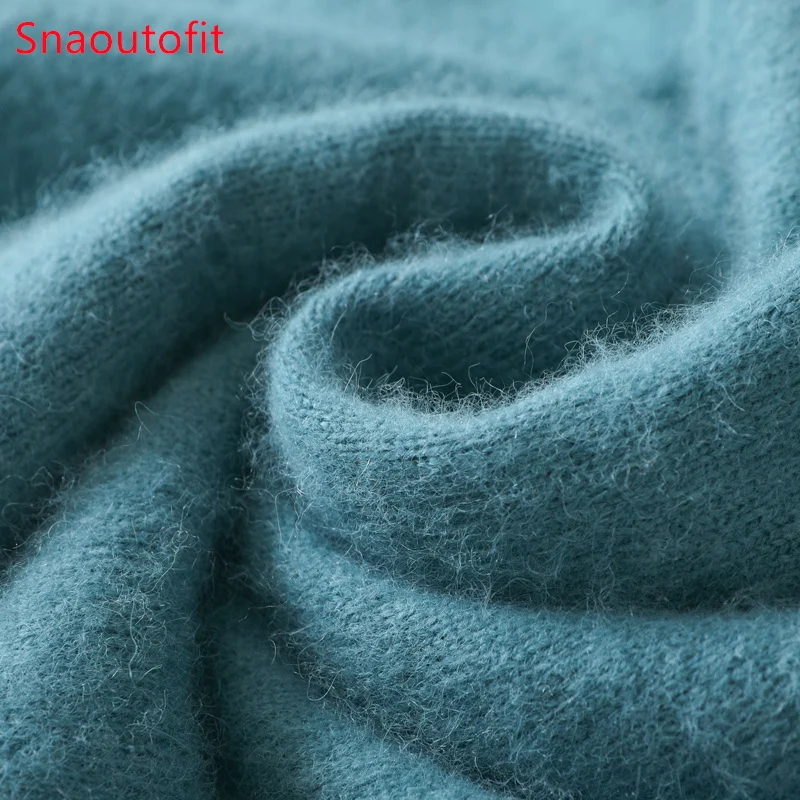
| Characteristic | Classic Cashmere | Brushed Cashmere |
|---|---|---|
| Manufacturing Process | Traditional processing that maintains natural fiber alignment | Additional brushing process that raises surface fibers |
| Tactile Sensation | Smooth, dense, silky hand-feel with natural elasticity | Fluffy, lofty, velvety texture with cloud-like softness |
| Visual Appearance | Clean surface with subtle natural sheen and defined stitches | Matte, fuzzy surface with soft, blurred stitch definition |
| Warmth Profile | Excellent natural warmth with efficient insulation | Enhanced warmth due to increased air trapping between raised fibers |
| Durability & Pilling | Generally better resistance to pilling with proper care | May show wear more quickly due to raised fibers |
| Care Requirements | Standard gentle cashmere care | May require more careful handling to maintain loft |
| Typical Aesthetic | Refined, polished, sophisticated | Cozy, relaxed, approachable |
| Price Considerations | Generally comparable at similar quality levels | Additional processing may add slight cost |
The manufacturing difference between these two cashmere types directly influences all their other characteristics. Classic cashmere preserves the natural alignment of fibers, while brushed cashmere deliberately disrupts this arrangement on the surface to create its distinctive feel.
This fundamental difference explains why classic cashmere feels smooth and dense while brushed cashmere creates that cloud-like softness. When fibers remain aligned as in classic cashmere, they create a uniform surface that reflects light consistently, producing that subtle sheen. When brushed, the raised fibers catch light at countless different angles, diffusing it and creating the matte appearance.
The warmth difference is particularly interesting from a technical perspective. Both types use identical cashmere fibers with the same inherent insulating properties. However, by creating more space between surface fibers, brushing traps additional pockets of air, which serve as extra insulation. This makes brushed cashmere feel noticeably warmer in identical weights.
Durability considerations stem directly from the structural differences. In classic cashmere, fibers remain more firmly anchored within the fabric structure, potentially resisting everyday friction better. The raised fibers in brushed cashmere, while creating that desirable softness, may be more vulnerable to catching and pulling during wear.
Both types require proper care techniques to maintain their best qualities. However, brushed cashmere may need slightly more attentive care to preserve its loft and prevent premature flattening of the raised surface.
The aesthetic difference creates distinct style differences between cashmere finishes, with classic cashmere projecting refinement while brushed varieties signal comfort and casual luxury. Neither is inherently “better” – they simply serve different style preferences and wearing occasions.
Pros and Cons: Evaluating Both Cashmere Types
Brushed Cashmere Pros:
- Unparalleled initial softness against the skin
- Superior insulation for maximum warmth
- Cozy, enveloping comfort ideal for relaxation
- Distinctive plush texture creates visual interest
- Particularly comfortable for those with sensitive skin
Brushed Cashmere Cons:
- May shed fibers more readily than classic cashmere
- Can potentially flatten or lose loft in high-friction areas over time
- Might be more prone to pilling due to raised surface fibers
- Sometimes too warm for transitional seasons or milder climates
- Casual appearance may be less versatile for formal settings
Classic Cashmere Pros:
- Exceptional durability and longevity with proper care
- Superior shape retention and structure
- Versatile appearance appropriate for casual to formal settings
- Elegant drape that showcases the garment’s design
- More resilient against everyday wear and friction
Classic Cashmere Cons:
- May not feel quite as soft to initial touch as brushed varieties
- Typically less insulating than equivalent brushed cashmere
- Refined appearance might feel too formal for very casual settings
- Shows stains more readily due to smoother surface
- Can occasionally feel less cozy for pure lounging comfort
When considering which type might better suit your needs, lifestyle factors play a significant role. Those living in extremely cold climates might appreciate brushed cashmere’s superior insulation for outdoor wear. Professional environments often favor classic cashmere’s refined appearance and structured drape. For layering needs, classic cashmere’s smoother surface slides more easily under jackets and coats without bunching.
Many cashmere enthusiasts find that having both classic and brushed options in their wardrobe provides the best of both worlds. Classic pieces might serve professional and versatile daily wear needs, while brushed items provide the ultimate comfort experience for relaxation and casual occasions.
The selection ultimately comes down to prioritizing your personal preferences regarding appearance, feel, function, and the specific items you’re considering. Neither type represents a compromise in quality – they simply offer different expressions of cashmere’s natural luxury.
Understanding Cashmere Quality Factors
While the distinction between classic and brushed finishes is important, understanding broader cashmere quality factors is essential for making informed purchases. It’s also crucial to distinguish between genuine cashmere and materials labeled with “cashmere feel” – a term sometimes used for synthetic alternatives that mimic cashmere’s properties but lack its natural benefits.
Several critical quality factors affect both classic and brushed cashmere performance:
Fiber grade: The quality of the raw cashmere fibers used dramatically impacts the final product. Higher grade cashmere comes from the finest, thinnest fibers, which create softer, more durable garments. Estate Cloth uses only premium grade cashmere fibers for superior performance.
Fiber length: Longer cashmere fibers create stronger yarns with less tendency to pill. Shorter fibers, while sometimes less expensive, often lead to increased pilling and reduced garment longevity.
Yarn construction: How the fibers are spun into yarn affects everything from softness to durability. Well-constructed yarns balance tension and twist to create optimal performance.
Knitting or weaving quality: The density and consistency of knitting or weaving significantly impact both appearance and durability. Higher-quality pieces have more consistent, tighter construction.
Finishing processes: Beyond the brushing distinction, other finishing processes like washing methods and treatments affect the final hand feel and performance.
These quality factors remain equally important regardless of whether you choose classic or brushed cashmere. A high-quality brushed cashmere piece will always outperform a low-quality classic cashmere item, and vice versa. The finish type is simply one aspect of the overall quality equation.
When shopping, several indicators can help identify quality cashmere. Better pieces generally have a smooth, even appearance without obvious thin spots. They feel substantial despite cashmere’s natural lightness. When gently stretched, high-quality cashmere springs back to shape quickly. These quality aspects enhance the versatility across styles for both classic and brushed cashmere garments.
Cashmere Wrap Sweaters, Women's Cashmere Pullovers
$75.89 Select options This product has multiple variants. The options may be chosen on the product pageCashmere Cable Knit Sweaters, Women's Cashmere Pullovers
Price range: $111.82 through $112.93 Select options This product has multiple variants. The options may be chosen on the product pageCropped Cashmere Sweaters, Women's Cashmere Pullovers
$155.77 Select options This product has multiple variants. The options may be chosen on the product page- Price range: $102.02 through $109.37 Select options This product has multiple variants. The options may be chosen on the product page
Oversized Cashmere Sweaters, Plus Size Cashmere Sweaters, Women's V-Neck Cashmere Sweaters
$136.87 Select options This product has multiple variants. The options may be chosen on the product page- Price range: $108.11 through $130.03 Select options This product has multiple variants. The options may be chosen on the product page
Remember that regardless of finish type, investing in quality cashmere pays dividends through longevity, better appearance, and superior comfort over many years of wear.
How to Care for Both Cashmere Types
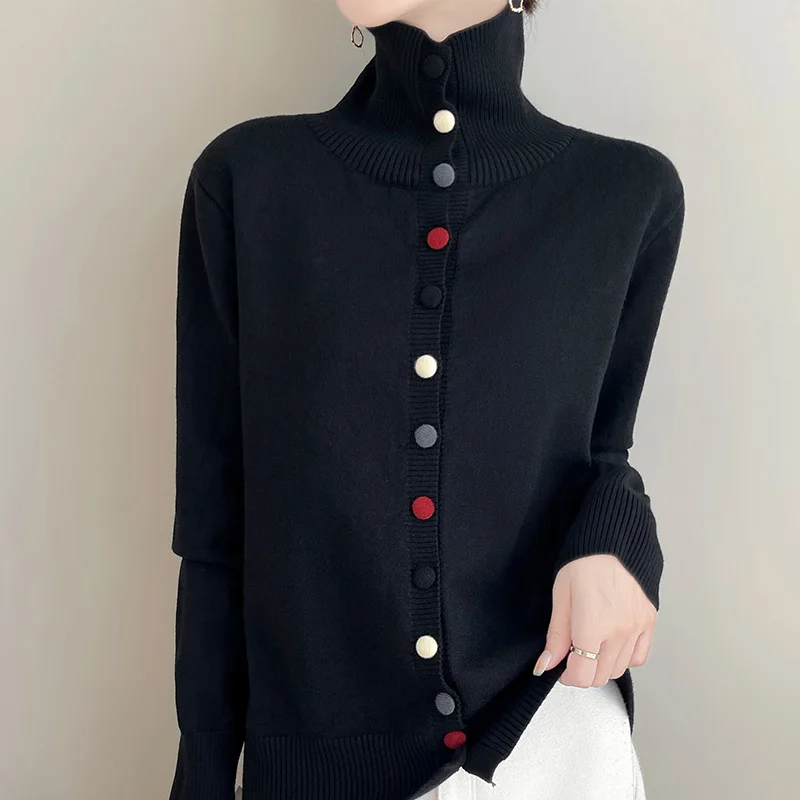
Proper care is essential for maintaining the beauty and longevity of both classic and brushed cashmere. While the general principles remain the same for both types, each has specific considerations to preserve its distinctive qualities.
General Cashmere Care Principles:
- Hand wash whenever possible using lukewarm water and mild cashmere shampoo or gentle soap
- Never wring or twist cashmere when wet – press water out gently
- Lay flat to dry on a clean towel away from direct heat or sunlight
- Store clean and folded with cedar blocks to deter moths
- Give rest between wearings to allow fibers to recover their natural loft
Specific Care for Classic Cashmere:
To maintain classic cashmere’s smooth surface and elegant drape, focus on preserving the natural alignment of fibers. When washing, avoid agitation that could disrupt this alignment. After drying, gently steam (never iron directly) to refresh the surface and enhance the natural sheen. Store folded rather than hung to prevent stretching.
For preventing pilling on classic cashmere, use a high-quality cashmere comb or sweater stone at the first sign of pilling, working in one direction with gentle strokes. Avoid friction against rough surfaces, and consider using garment bags when storing multiple pieces together.
Specialized Care for Brushed Cashmere:
Brushed cashmere requires particularly gentle handling to preserve its distinctive loft. When washing, use minimal agitation and avoid pressing too firmly when removing water. When drying, occasionally lift and shake the garment gently to restore loft as it dries.
To maintain brushed cashmere’s plush surface, avoid using sweater combs or stones that might further disrupt the deliberately raised fibers. Instead, carefully remove pills individually by hand if they appear. Store with minimal compression – avoid placing heavy items on top of folded brushed cashmere.
Both types benefit from seasonal care routines. Before storing for off-seasons, ensure pieces are clean and completely dry to prevent moth damage. Various cashmere styles may have specific care needs based on their construction and details, so always check care labels for any special instructions.
With proper care, both classic and brushed cashmere can provide many years of luxurious wear, making them true investment pieces for your wardrobe.
Making Your Choice: Which Cashmere Feel Is Right for You?
Selecting between classic and brushed cashmere ultimately comes down to your personal preferences, lifestyle needs, and how you plan to use the garment. Consider these guiding questions to help determine which might better suit your needs:
Do you prioritize ultimate softness and immediate comfort? If your primary goal is the most cloud-like, gentle feeling against your skin, brushed cashmere delivers an unmatched sensory experience that feels instantly comforting.
Is longevity and versatility your main concern? For pieces you plan to wear regularly across various settings for many years, classic cashmere typically offers better durability and adaptability to different style contexts.
What’s your typical environment? For extremely cold climates, brushed cashmere’s superior insulation provides maximum warmth. For moderate or variable climates, classic cashmere’s adaptability may serve better across seasons.
How will you use the item? Professional settings generally favor the refined appearance of classic cashmere. Relaxation contexts benefit from brushed cashmere’s cozy comfort. Consider how versatile outfit options might influence your decision.
What’s your personal style aesthetic? If you prefer polished, sophisticated looks, classic cashmere complements this style direction. If your style leans toward relaxed comfort with textural interest, brushed cashmere aligns beautifully.
Different garment types may also suggest different choices. Structured pieces like fitted sweaters and cardigans often work best in classic cashmere to maintain their intended shape. Relaxed pieces like oversized sweaters and throws can showcase brushed cashmere’s comfort beautifully. Lightweight classic cardigans serve different purposes than chunky brushed pullovers.
Many cashmere enthusiasts discover that building a collection that includes both types provides the most comprehensive luxury experience. You might select classic cashmere for professional and versatile pieces while choosing brushed options for items dedicated to comfort and casual wear.
Remember that quality transcends finish type – a well-made piece in either finish will provide a superior experience compared to a lower-quality alternative. Consider your specific needs and preferences, then select the option that best aligns with how you’ll use and enjoy your cashmere investment.
Is Cashmere Feel Without Cashmere Possible?
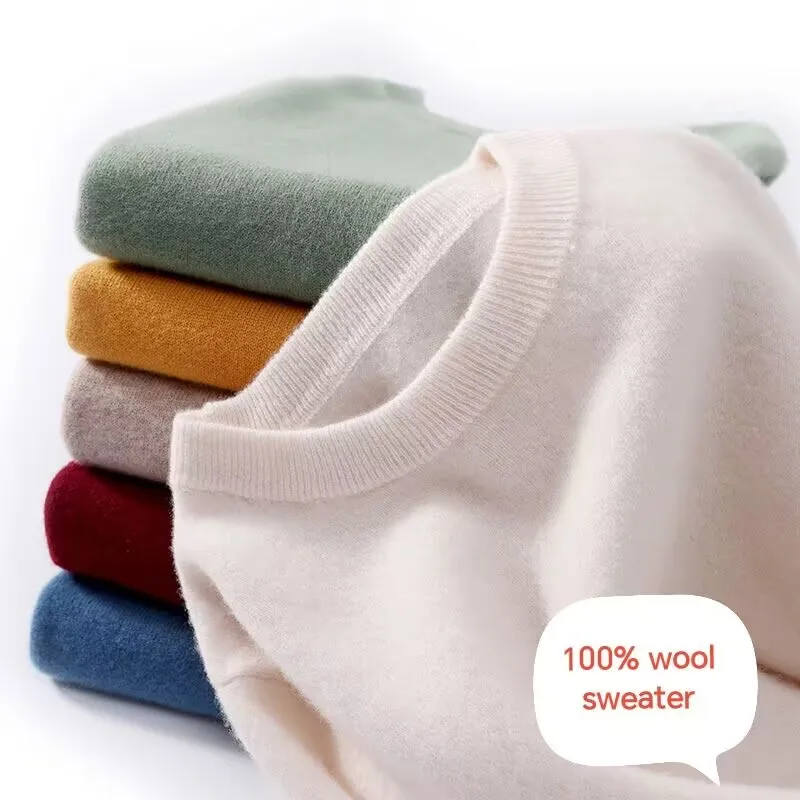
The term “cashmere feel” has become increasingly common in the textile market, referring to materials that attempt to mimic cashmere’s distinctive properties without actually containing cashmere fibers. Understanding these alternatives helps make more informed purchasing decisions.
Several approaches exist to create cashmere-like qualities in other materials:
Cashmere blends combine genuine cashmere with other fibers like silk, wool, or synthetic materials. Common blends include cashmere-silk (adding lustrous drape), cashmere-wool (improving durability while reducing cost), and cashmere-synthetic blends (increasing stretch and reducing price). These blends can be either brushed or classic in finish, but the non-cashmere content alters the natural properties of pure cashmere.
Treated natural fibers like merino wool or alpaca can undergo special processing to increase softness and create more cashmere-like characteristics. While these can be lovely materials in their own right, they lack cashmere’s distinctive combination of lightness, warmth, and natural hand feel.
Synthetic alternatives include various acrylic, polyester, or rayon materials engineered to mimic cashmere’s softness. While technologies have improved dramatically, these lack cashmere’s temperature regulation, breathability, and aging characteristics.
The advantages of genuine cashmere remain significant. Authentic cashmere provides natural breathability and temperature regulation that synthetic alternatives can’t replicate. It also develops character over time, often becoming softer with proper care while maintaining structure. The lightweight warmth of real cashmere comes from the fiber’s natural properties rather than artificial treatments that may diminish over time.
When examining products claiming “cashmere feel,” check fiber content labels carefully. Pure cashmere should be labeled as 100% cashmere. Blends must list percentages of each fiber. Terms like “cashmere-like,” “cashmere touch,” or “cashmere feel” without specific cashmere content listed generally indicate alternative materials designed to mimic cashmere.
While alternatives may be appropriate in certain contexts, understanding what you’re purchasing ensures realistic expectations about performance, longevity, and the true luxury experience that only genuine cashmere can provide.
FAQ: Common Questions About Cashmere Finishes
Does brushed cashmere pill more than classic cashmere?
Brushed cashmere may show pilling more quickly due to the already-raised surface fibers being more vulnerable to friction. However, the quality of the underlying cashmere is a more significant factor – high-quality brushed cashmere can outperform low-quality classic cashmere in pilling resistance. Proper care techniques can minimize pilling for both types.
Can classic cashmere become brushed over time?
While classic cashmere may develop a slightly softer surface with wear and washing, it won’t transform into true brushed cashmere. The deliberate brushing process creates a much more dramatic effect than natural wear. Some classic cashmere pieces may develop a subtle halo effect over time, but this differs significantly from professional brushing.
Which type is warmer for winter wear?
Brushed cashmere typically provides greater warmth in identical weights due to the increased air trapped between raised surface fibers. This makes brushed cashmere particularly valuable for severe winter conditions. However, classic cashmere can be knitted in heavier weights to provide comparable warmth when needed.
Is one type more durable than the other?
Classic cashmere generally offers better durability and longevity with proper care. The intact fiber structure resists everyday abrasion better than the raised fibers of brushed cashmere. However, high-quality brushed cashmere will still outperform lower-quality classic cashmere – the underlying quality matters most.
How can I tell if cashmere is brushed before purchasing online?
Product descriptions should specify the finish, often using terms like “brushed,” “lofty,” or “ultra-soft” for brushed varieties, while classic cashmere might be described as “refined,” “smooth,” or simply “classic.” Product images may show the distinctive surface texture, with brushed cashmere appearing hazier and less defined. When in doubt, contact the retailer for clarification about the specific finish.

